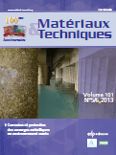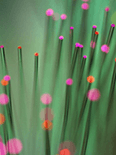
Oxford Open Materials Science
Scope & Guideline
Pioneering Insights for Tomorrow's Technologies
Introduction
Aims and Scopes
- Materials Design and Characterization:
The journal emphasizes research on the design and characterization of advanced materials, including nanocomposites, biomaterials, and metamaterials. Studies often involve sophisticated techniques such as DFT (Density Functional Theory) and various experimental methodologies. - Sustainable and Bio-based Materials:
A core area of focus is on developing sustainable materials, including bio-based composites and materials with antimicrobial properties. This reflects a growing trend towards environmentally friendly and health-conscious materials in applications such as food packaging. - Energy Materials and Devices:
Research related to energy storage and conversion materials, including batteries, solar cells, and thermoelectric materials, is prevalent. The journal publishes studies that explore new chemistries and material architectures to improve efficiency and performance. - Additive Manufacturing and 3D Printing:
There is a significant emphasis on additive manufacturing techniques and their applications in materials science. Papers often explore the mechanics of 3D printing processes and the properties of printed materials, indicating a growing interest in this innovative manufacturing technology. - Machine Learning and Computational Methods:
The integration of machine learning and computational techniques in materials design is a notable focus. The journal publishes studies that apply AI and machine learning to optimize material properties and processes, highlighting the intersection of materials science and data science.
Trending and Emerging
- Nanocomposites and Hybrid Materials:
There is a growing emphasis on the development and characterization of nanocomposites and hybrid materials, which combine multiple components to achieve enhanced properties. This trend aligns with the increasing interest in lightweight and high-performance materials across various applications. - Machine Learning Applications in Materials Science:
The application of machine learning techniques to materials design and optimization is rapidly emerging. This trend represents a significant shift in how researchers approach material discovery and development, leveraging computational power for innovative solutions. - Sustainable Materials and Circular Economy:
Research focused on sustainable materials, including biodegradable and recyclable options, is on the rise. This trend reflects a broader societal push towards sustainability and the need for materials that minimize environmental impact. - Advanced Energy Storage Solutions:
The journal is seeing increased research on advanced energy storage solutions, particularly in the context of lithium-ion and next-generation batteries. The exploration of new materials and architectures for energy efficiency is crucial for addressing global energy challenges. - Metamaterials and Novel Functional Materials:
The exploration of metamaterials and other novel functional materials is gaining traction. This emerging theme indicates a growing interest in materials with unique properties that can be tailored for specific applications, particularly in optics and acoustics.
Declining or Waning
- Traditional Inorganic Materials:
Research focused on traditional inorganic materials, such as ceramics and metals, appears to be decreasing. This shift may be due to the increasing interest in novel materials and composites that offer superior properties or sustainability. - Conventional Polymer Studies:
The publication of studies on conventional polymers without significant modifications or innovations has seen a decline. This trend suggests a move towards more advanced polymer composites and bio-based alternatives rather than standard polymer research. - Basic Theoretical Studies without Application Focus:
There is a noticeable reduction in purely theoretical studies that do not connect to practical applications. The journal seems to favor research that demonstrates real-world implications and applications of material science, moving away from abstract theoretical discussions.
Similar Journals

BULLETIN OF MATERIALS SCIENCE
Unveiling Breakthroughs in Material DevelopmentBulletin of Materials Science, published by the Indian Academy of Sciences, is a distinguished journal that has been contributing to the field of materials science since its inception in 1979. With an ISSN of 0250-4707 and E-ISSN 0973-7669, it provides a platform for researchers to share groundbreaking studies and advancements in the mechanics of materials and general materials science. As of 2023, the journal holds a respectable Q3 ranking in both the Materials Science (miscellaneous) and Mechanics of Materials categories, highlighting its competitive position in the academic landscape. Although the journal currently does not operate under an open access model, it remains a vital resource for professionals and students keen on exploring innovative material developments and methodologies. With a commitment to promoting high-quality research, the Bulletin of Materials Science features rigorous peer-review processes, making it an essential reference for anyone engaged in the materials science domain.

FlatChem
Unveiling Cutting-Edge Research in Materials ChemistryFlatChem, an esteemed journal published by ELSEVIER, serves as a premier platform for disseminating high-quality research in the dynamic fields of ceramic and composite materials, electronic and optical materials, materials chemistry, and surfaces, coatings, and films. Since its inception in 2017, the journal has garnered a robust reputation, evidenced by its rank in the top quartile (Q1) across multiple categories, including a commendable rank of #25/127 in Ceramics and Composites and #49/284 in Electronic, Optical and Magnetic Materials. With a focus on pioneering advancements and innovative methodologies, FlatChem not only highlights cutting-edge research but also promotes collaboration and knowledge exchange within the scientific community. The journal’s impact is underscored by its impressive rankings in Scopus, marking it as a vital resource for researchers, professionals, and students aiming to stay at the forefront of materials science. As an open-access journal, it ensures that groundbreaking findings are readily accessible, fostering a broader understanding and application of materials innovation worldwide. The journal is based in the Netherlands, with its headquarters located at RADARWEG 29, 1043 NX AMSTERDAM, NETHERLANDS. Join the vibrant community contributing to FlatChem and engage with the forefront of material advancements.

Materiaux & Techniques
Fostering Excellence in Material Science DiscourseMateriaux & Techniques, published by EDP SCIENCES S A, is a prominent journal in the field of materials science, specifically focusing on diverse and innovative techniques in material development and application. With an ISSN of 0032-6895 and an E-ISSN of 1778-3771, this French journal serves as a key resource for researchers and professionals looking to advance their knowledge and share their findings within the community. The journal holds a Q3 ranking in Materials Science (miscellaneous), indicating its role in contributing to various facets of material science research amidst a growing field. Despite operating under a traditional access model, it provides a platform for rigorous peer-reviewed studies and significant advancements in material technology. With a publication history tracing back to the late 1970s and extending through to 2024, Materiaux & Techniques continues to uphold its commitment to fostering high-quality discourse and innovation in materials science.

Annual Review of Materials Research
Shaping the Future of Materials ResearchThe Annual Review of Materials Research, published by ANNUAL REVIEWS, is a pivotal journal in the realm of Materials Science, recognized for its rigorous reviews that bridge the gap between foundational research and advanced applications. With a prestigious ranking of Q1 in the category of General Materials Science and a commendable position at #24 out of 463 in Scopus, it ranks in the 94th percentile among its peers, underscoring its significance and influence in the field. Over the years, from 2003 to 2023, the journal has become an essential resource for researchers, professionals, and students alike, offering comprehensive insights into the evolving landscape of materials science. Although it does not operate under an open access model, its content remains invaluable for advancing knowledge and fostering innovation. The journal’s scope encompasses a wide array of interdisciplinary topics, making it a go-to source for those seeking to stay at the forefront of materials research.

Materials Today Advances
Unlocking innovations in materials and mechanical engineering.Materials Today Advances is a premier open access journal, published by Elsevier, dedicated to disseminating cutting-edge research in the fields of Materials Science and Mechanical Engineering. Since its inception in 2019, the journal has quickly established itself within the academic community, achieving an impressive Q1 quartile ranking in both disciplines as of 2023, indicative of its high-impact contributions. Ranked #25 out of 672 in Mechanical Engineering and #46 out of 463 in General Materials Science according to Scopus, Materials Today Advances offers rigorous peer-reviewed articles that address the latest innovations and interdisciplinary approaches. Researchers, professionals, and students can benefit from the journal's open access model, ensuring widespread visibility and accessibility of groundbreaking findings. With the convergence of advanced materials research and practical applications, this journal represents a vital resource for those at the forefront of scientific discovery.

Frontiers of Materials Science
Empowering Researchers with Open Access to Materials ScienceFrontiers of Materials Science is a groundbreaking journal dedicated to exploring advanced materials and their applications within the ever-evolving landscape of materials science. Published by HIGHER EDUCATION PRESS, this journal offers a crucial platform for scholars and practitioners seeking to disseminate innovative research findings that foster interdisciplinary collaboration. Since its inception in 2011, the journal has enjoyed a notable Q2 ranking in the category of Materials Science (miscellaneous) as of 2023, positioning it among the noteworthy publications in the field with a Scopus rank of #222 out of 463. While predominantly published in China, the journal is committed to open access principles, allowing global accessibility to cutting-edge research. With its comprehensive coverage spanning materials synthesis, characterization, properties, and applications, Frontiers of Materials Science not only serves as a repository for academia but also bridges the gap between research and industry, making it an indispensable resource for researchers, professionals, and students alike.

Interdisciplinary Materials
Advancing the Frontiers of Materials ScienceInterdisciplinary Materials is a prominent Open Access journal published by Wiley, dedicated to advancing knowledge and innovation in the field of materials science. With an ISSN of 2767-4401 and an E-ISSN of 2767-441X, this journal seeks to foster interdisciplinary collaborations and promote high-quality research that bridges the gap between materials engineering, physics, chemistry, and emerging technologies. Established in 2022, it aims to provide free and unrestricted access to cutting-edge research findings, ensuring that pivotal discoveries reach a broad audience. Interdisciplinary Materials assesses submissions rigorously, aspiring to achieve high impact and relevance, catering to researchers, professionals, and students keen on exploring innovative materials and their applications. With its commitment to scientific excellence, this journal stands as a vital resource for those looking to stay abreast of the latest advancements in materials research.

Energy & Environmental Materials
Bridging Science and SustainabilityEnergy & Environmental Materials, published by WILEY, is an esteemed academic journal dedicated to pioneering research in the multifaceted domains of energy, environmental science, and materials science. Since its inception in 2018, this journal has rapidly established itself as a leading platform, holding a prestigious Q1 ranking across multiple categories including Renewable Energy, Sustainability, and Waste Management, reflecting its significant contributions to advancing knowledge in these critical areas. With a robust Scopus ranking that positions it in the top percentile for Environmental Science and Materials Science, it caters to a diverse audience of researchers, professionals, and students seeking cutting-edge findings and practical applications in energy efficiency and sustainable materials. This open-access journal facilitates the dissemination of innovative research and aims to bridge the gap between scientific exploration and real-world solutions for a sustainable future. The editorial team encourages submissions that explore both theoretical and practical aspects, ensuring that every publication not only contributes to the academic landscape but also drives impactful change in energy and environmental practices.

PROCEEDINGS OF THE INSTITUTION OF MECHANICAL ENGINEERS PART L-JOURNAL OF MATERIALS-DESIGN AND APPLICATIONS
Fostering Collaboration in Mechanical Engineering and Materials SciencePROCEEDINGS OF THE INSTITUTION OF MECHANICAL ENGINEERS PART L-JOURNAL OF MATERIALS-DESIGN AND APPLICATIONS is a prestigious academic journal published by SAGE PUBLICATIONS LTD, focusing on the dynamic fields of mechanical engineering and materials science. With an impressive impact factor reflective of its rigorous scholarly contributions, this journal serves as a vital platform for the dissemination of innovative research and practical applications in materials design and engineering processes. Since its inception in 1999 and continuing through 2024, it has maintained a robust reputation, achieving a Q2 ranking in both Materials Science (miscellaneous) and Mechanical Engineering categories, as well as commendable Scopus ranks that place it in the top percentiles of its fields. Located in the United Kingdom, the journal encourages submissions from researchers and professionals who are seeking to advance their understanding of materials applications while fostering interdisciplinary collaboration. Although it currently operates under traditional access terms, the journal prioritizes impactful research that addresses contemporary challenges in design and manufacturing, ensuring that it remains a must-read for anyone invested in the innovations shaping our technological landscape.

MATERIALS AND MANUFACTURING PROCESSES
Driving Impactful Discoveries in Materials and Manufacturing.MATERIALS AND MANUFACTURING PROCESSES, published by Taylor & Francis Inc, is a leading journal dedicated to the dynamic fields of materials science and manufacturing engineering. Established in 1989, the journal has built a formidable reputation, exemplified by its prestigious Q1 rankings in 2023 across various categories, including Industrial and Manufacturing Engineering, Materials Science, Mechanical Engineering, and Mechanics of Materials. With a robust focus on innovative research and the latest advancements in manufacturing techniques and materials application, the journal serves as a vital resource for researchers, professionals, and students alike. The journal is indexed in renowned databases and boasts high impact factors, reflecting its influence in the academic community. Although it does not offer open access, it provides extensive platforms for disseminating crucial findings that push the boundaries of engineering and science. For those seeking impactful research contributions, MATERIALS AND MANUFACTURING PROCESSES remains at the forefront of fostering scholarly dialogue and advancing the field.